How I Made A Solar Eclipse Selfie
by Marcel Siegle
Since winning the Weather Channel’s “It’s Amazing Out There Photo Contest” people have asked me how my shot “Celestial Encounter” was done. Some on social media thought it was a composite or some kind of photoshop trickery. The fact is the shot took a lot of planning and three days to execute. So to set the record straight, here is the story of how this shot was created. Apologies in advance, it’s kind of long.
Vision:
If you’ve seen some of my personal work you know that fly-fishing is a big part of my life. Some of you fly-fishermen and women might have seen my work in the FlyShop Catalog or occasionally in fly-fishing magazines. While my assignment work is more commercial, my personal fine-art work explores different areas of the sport that go beyond the “Grip and Grin” and “Fish Porn” that has become the standard. I think for most people who pursue the sport, fly-fishing is not just about catching fish. For me, fly-fishing is about the journey, the challenges, the people I meet and the often visceral connection I get with nature. My work is more about observation and landscapes, and trying to capture the essence of the sport. So clearly, any solar eclipse shot I was going to do, had to have a fly-fisherman in it. But I wasn’t clear on how, where, and who?
Location Scouting:
Thank Google for Google Maps. Once I read about the path of the full solar eclipse I began “dropping pins” in Google Maps. In order to experience a full eclipse I would have to travel, and the closest location for a full eclipse was in Oregon. First, I thought I’d go to the North Umpqua, a good choice for me because it would mean I would also get to fish for steelhead. But it turned out the Umpqua was not really in the path of the full eclipse and there was a good chance I wouldn’t even see it, since I would be on the wrong side of the mountain range. With all my planning I forgot that the eclipse was in the morning and as a good friend pointed out, I needed to be focusing on the eastern sky.
The other river in Oregon that I had in mind was the Deschutes, a major tributary to the Columbia, a steelhead river and one of the most scenic rivers in Oregon. It is also a hot hellhole in summer without shade, but more about that later. Once I decided on the river, I started calling fly shops and guides and asking them for suggestions. This helped me narrow down potential locations within a five 5 mile stretch of the Deschutes that might just work.
How:
Now that I had my location, I had to come up with a feasible schedule. I knew it would take me a good 8-10 hours to drive up there. I needed enough time to find a camp site, do some location scouting; and I would have to do a test shoot at the exact time of the eclipse the day before, just to make sure that whatever composition I came up with would work. In all I would need a minimum of three days, which was tight.
Who – Finding a Model:
As soon as I had my location and plan together I started calling around to see if I could find someone to tag along to be my model. Unfortunately my excitement didn’t carry over to any of my friends. Even the offer of a free trip and all the beer you can drink did not get any bites. Most had to work, others were not really convinced they wanted to go to the Deschutes in August. But most surprisingly people were just not that excited about a solar eclipse. So now I had a dilemma, I could go out there and try to find some random fisherman and try to talk him into it, which would be kind of weird, or I could photograph myself. The latter option is really something I wanted to avoid. Trying to photograph yourself is very limiting and there are so many variables and things that can go wrong. But if I wanted to pull off the shot of a lifetime, this became my only feasible option.
The Trip:
I left on the evening of the 18th of August. The eclipse was due to happen on the 21st. The idea was that I would drive for about five hours and camp at one of my favorite campsites off Interstate 5 north of Shasta Dam. The plan was sound, I’d drive a good portion at night, beat the traffic, sleep for a few hours and then get up really early and continue on my way. Well, when I got to my favorite campsite, it was full. The first time ever I had seen it full. Even some of my secret “off the road” camping spots were taken. It became very clear, very fast, that I was not the only one heading up north to see the solar eclipse. Not tired, I kept on driving, checking some campsites here and there, just to find the same situation. What was even more astonishing was that even the rest stops where full. I mean rest stops in places where there is hardly a car on a normal day.
Once I got into Oregon, I ran into people who were going the opposite direction. At one gas station I was approached by a young man. He asked me if I was going to see the eclipse, to which I nodded and asked him if he was heading there too? He chuckled and said that he is from Oregon and was getting the hell out of dodge. He was predicting utter chaos, “There are only two roads and more than half a million people trying to get in and out!” he said. He was not the only Oregonian I ran into that was leaving to escape the “Eclipsocalypse.” Did they know something I didn’t know? Should I be worried, I asked myself?
I continued on to Klamath Falls in one straight shot, crashing for an hour near the local Dutch Bros; and after re-caffeinating with a quadruple Americano I was on my way again. Radio reports of gas stations running out of gas kept pouring in. I was already filling up gas every 50 miles or so since Klamath Falls, just to make sure I would not run out. I even tried to buy a five gallon gas canister, but it turned out they were all sold out.
I had one more stop to make, the Confluence Fly Shop in Bend. I always like to stop by the local fly shops to stock up, get some local flies and most importantly, collect intel. I am glad I did, after explaining what my mission was, one of the guys took out a map and showed me the perfect spot.
Once back at my car I Googled his recommended spot. It turned out to be one of the three spots I had already marked. This was a good sign and would save me a tremendous amount of time scouting each location. There was only one hitch; the spot was on the Warm Springs Indian Reservation and I had to get a special camping/fishing permit. And to get this permit I had to go to some grocery store in Madras, which seemed easy enough. Better yet the store had a catchy name even I could remember, “Tiger Mart.” How hard could it be? I soon found out that finding this store became a real headache. Google constantly navigated me to a gas station, but there was no Tiger Mart. Of course being a real man I don’t ask for directions and kept circling and zig-zagging through insane eclipse traffic. Sometimes things happen for a reason, and fortunately Google maps suddenly decided I was a pedestrian and directed me to drive into a one way street the wrong way, which got me pulled over immediately. Now you might think what is so lucky about that? As it turned out the cop had no interest in writing me up, there were a million people coming through his town and he obviously had bigger fish to fry. After explaining my predicament and having my drivers license checked, he pointed me in the right direction. It turned out theTiger Mart had changed name and ownership and was now a “Circle K” market, corporate branding and all. It was right next to the the gas station I had been circling. Letting me off with a friendly warning, the cop was on his way and I finally found the elusive market with the key to the promised land
Setting Up Camp
While getting closer to my destination the traffic became thicker and thicker. Gigantic tent cities started popping up along the road and I started to wonder if I would even find a space at my destination. I finally arrived at the campsite at around 2:30pm. There were already some campers there, but it was nothing like the tent cities I had seen earlier, I was relieved. The only problem was that all the good spots were taken. As I mentioned earlier, one of the issues with the Deschutes in summer is, it gets extremely hot and shade is hard to come by. I first settled into a spot that I thought could work. It had partial shade, but I was right on a dirt road, close to the only bathroom, not the ideal situation. I then scouted around and found the perfect campsite. I couldn’t believe it, all these people camped out in full sun, and there was this awesome spot, with plenty of shade and a meadow, and nobody took it? Of course there was a catch, there was a ton of trash. Fortunately, I always carry trash bags in the car and after spending less than an hour, I had finished my good deed for the day and was rewarded with the best private camp spot anyone could ask for. I had arrived.
Final Location Scouting and Prepping the Shoot.
Well now I finally get into the nitty-gritty, if you’re still reading, thanks for hanging in there. So once I had set up camp, I headed out for the final location scouting. I had two days to the eclipse. I geared up in my waders and headed downstream, stopping at various locations and checking out different angles. About a mile downriver I found the perfect location. Intuitively I knew this would be the spot. The only question now was, where will the sun be during the time of the eclipse? Will it be hidden behind the ridge, or would it be too high and not work compositionally? There was only one way to find out, come back the next day, during the estimated time of the eclipse and do a test shoot. After I was satisfied I had found my ideal location, I went back to camp. The heat was getting to me and it was important I got some rest and a well deserved beer break.
The next day I got up early, geared up in full fly-fishing attire and hiked to my shoot location with a good amount of photo gear. I set up a tripod and started playing with some compositions. This is where shooting yourself becomes a real pain-in-the-ass. I really loved the scene, but I had a hard time figuring out where I should stand and how I should pose. Using a wireless remote to trigger my camera and being able to remotely get pictures onto my phone via camera wifi helped. But I had to pace back and forth, in and out of the water, several times. I was hoping no one would see me posing like a fashion model, but hey, if you want to get the shot, you can’t be bashful. After I finally figured out my composition, I waited for the sun to move to it’s 10:20am position (the approximate time of the eclipse) and did some more test shots. Things were starting to look good.
The Day of the Solar Eclipse
I’ve not been as nervous about any shoot as I was that day. I got up before sunrise and double and triple-checked my gear. I had made some decisions on what to take and what not to take the day before.
As always, I had made a plan as to how I was going to shoot the eclipse. But just in case, I also made sure I had everything in case I needed to change my plan. I am glad I did. Since my shoot location was next to a steep slope, I decided to only take my camera tripod and no light-stands, as it would have been a real hassle to use stands in that rocky terrain and I didn’t want to schlep any more than I had to. I did take some clamps though, as well as a couple of speedlights (external flash) and a remote. I also took a reflector, something I was not sure I would actually use as there wouldn’t be any light to reflect during a full solar eclipse, but I still took it. Everything had to be thought through, even my attire. I decided to wear light-colored clothing to make sure I would stand out against the darkness that might ensue. I wore a white hat, which I would never use during a regular fly-fishing shoot and I even took a fly rod that had a white fly-line on it.
My original plan was to shoot a HDR image (High Dynamic Range) using multiple exposures. One exposure for the solar eclipse, which would be more like a daylight exposure setting, one for me — the fisherman, which would be a very long exposure, and one exposure somewhere in the middle, just to have the range. Now, I don’t normally shoot HDR images, in fact I hate HDR most of the time. I only considered it because I thought it would be best to shoot the eclipse with available light. Oh man, am I glad I didn’t stick to my plan!
Once I was at my location I started setting up my camera. Since I didn’t change my tripod height much or the tripod head’s angle from the day before, I had my composition in no time. But then I started contemplating. Was HDR really the way to go? What if it gets completely dark? What if my exposure for the fisherman is going to be so long that I capture motion and the image is blurry? And then there was another aspect, I would have to shoot three exposures, and then have to photoshop them together? Would that take away from the authenticity of the moment? Was I starting to get “moral” issues about it? I mean, I was “staging a shot” after all.
After elaborate testing, I made up my mind, the scene had to be lit; that is what I normally do, what I’m good at doing, and I knew it would give me control over the scene vs leaving it up to an unknown lighting situation. Once this decision was made, I had only 20 minutes to the eclipse.
As mentioned earlier, I hadn’t brought any light stands, nor did I bring any light modifiers, like a soft-box or an umbrella. I did bring a clamp with a mount for one of my flashes. I jerry-rigged a flash on a sturdy root. As a security-blanket, just to make me feel better, I positioned the reflector to the side as a fill, which was supposed to bounce some of the light from the flash. The problem now was to get the flash to point in the right direction and illuminate my celestial selfie. (Just in case photo-geeks are wondering, the flash did have a warming gel on it.)
A trick I use to get good light with a simple flash/speedlight, is that I zoom it in. I set the flash zoom to 200mm (max zoom) and pointed it sort off into the direction of my subject, which would be me in this instance. It’s a great setup during day time. The only problem with this setup, which is also it’s asset, is that it makes a very narrow beam of light. It can be a beautiful light, but it can also go horribly wrong, you have to aim it just right. The light quality is similar to a grid light, a narrow beam with a somewhat soft edge. The distance to the subject of course plays a crucial role in how the light falls off as well. In short, it achieves a somewhat natural and dramatic looking light without having to use modifiers. And since you are not using modifiers, it puts out a lot of power, which I would need anyway. I ended up positioning the light behind some vegetation, that feathered the light a bit more and also gave some detail to the vegetation in the shot itself.
While setting up and testing the light I was reminded why I had considered shooting HDR in the first place. The constant back and forth, adjusting, taking a shot, checking the light, going back, shooting a frame, was maddening, and time was running out. In addition, I had a hard time finding a constant position for myself. If I was not standing exactly in the same spot, the light would miss me, if I moved too far from the light I would loose half a stop of illumination or more. In order to orient myself, I marked some rocks in the river as a visual aid. Due to my constant back and forth though, I stirred up a lot of silt in the water and would lose my point of reference. When the eclipse happened would I even be able to see anything, I wondered?
My test shots pre-eclipse looked like shit. I didn’t like my poses, my position in the frame was off and on top of it I was running out of time. I also had to take care of the technical aspects now. Whereas before I was just going to do three different exposures, using my camera’s HDR mode, now I had a whole new set of parameters.
I set my final f-stop to f8, this would give me enough depth of field at 16mm. My ISO was set to 100 and my flash was shooting at half power or full power, to be honest I don’t remember what the final setting was. But most importantly my f-stop and ISO were married now with my flash. That threesome was going to be my one constant. The only variable now was the shutter speed, which would control the ambient. I knew it would get dark, but I had no idea how dark.
Above: Video of how the shot was done. The transitions of the Eclipse are in real time.
While the moon was slowly moving in front of the sun, the sky steadily became darker and colors started changing. As the ambient light was in decline, I set the shutter speed to a 1/20 of a second and did a few more tests. My last test shot with me in it was at 10:18am, I went back to the camera, checked the composition and finally liked what I saw. Then it went dark, just like that. The eclipse hit at 10:19am (my camera time stamp). I shot a quick few frames and realized it had become completely dark. I opened up the flood gates and slowed my shutter down to 1.6 seconds. An odd choice you might think, but I don’t think I even looked at what I was setting my shutter speed to, I just cranked the dial. I shot a few more frames and hurried to my spot in the dark river. Fortunately, by then I knew this tiny section of the river like the palm of my hand.
In total I managed to shoot eleven frames, and before I knew it, the great solar eclipse of 2017 was over. With all the stress surrounding this shoot and despite the fact that this shot was completely staged, my awe for this celestial event was genuine, and somehow it comes across in the final image. I truly had never experienced anything like it and most likely never will again.
Aftermath
When I first glanced at the images on my camera screen my heart sank. For a second I thought the pictures were completely under-exposed, but then when I looked at the exposure graph my shock receded. Everything was going to be ok, the exposure was within normal range.
Rumor had it that the “bite would be on” after an eclipse, well rumors are just rumors I guess. After a short while of uneventful fishing, the Deschutes reminded me about it’s unrelenting heat and I tracked back to the car and broke down camp. But before breaking camp I worked on a quick jpeg version of my solar eclipse image and posted it on social media right away and waited for the internet to explode. Of course that never happened.
My trip back home became a mini-adventure in itself, but I won’t bore you with that. You can see more pictures and videos about the trip and the shoot with captions below.
In Closing
In recent months I have thought a lot about this trip. I also thought a lot about my mother who had succumbed to cancer and had just passed that June. In fact, I went on this trip because I found my self in a deep slump after my mother’s passing and needed a project to get me out of my rut. She was my biggest fan, but always wondered about my fly-fishing addiction. The fact that I would travel so much, fish all day and then wouldn’t even keep the fish, puzzled her, and I know she is not the only one. But she always loved to see my pictures and even had some of my fly-fishing art hanging in her house. Once she asked me, “Why always the solitary fisherman, is it a lonely sport?” And I said “No, it’s just the opposite, while out there, I am completely connected.” I am sure she would have loved this shot.
Gear:
Camera: Canon 5DM3
Lens: Canon 15-35mm
Flash: Speedlights 600EXRT
Here are some more pictures from my trip.
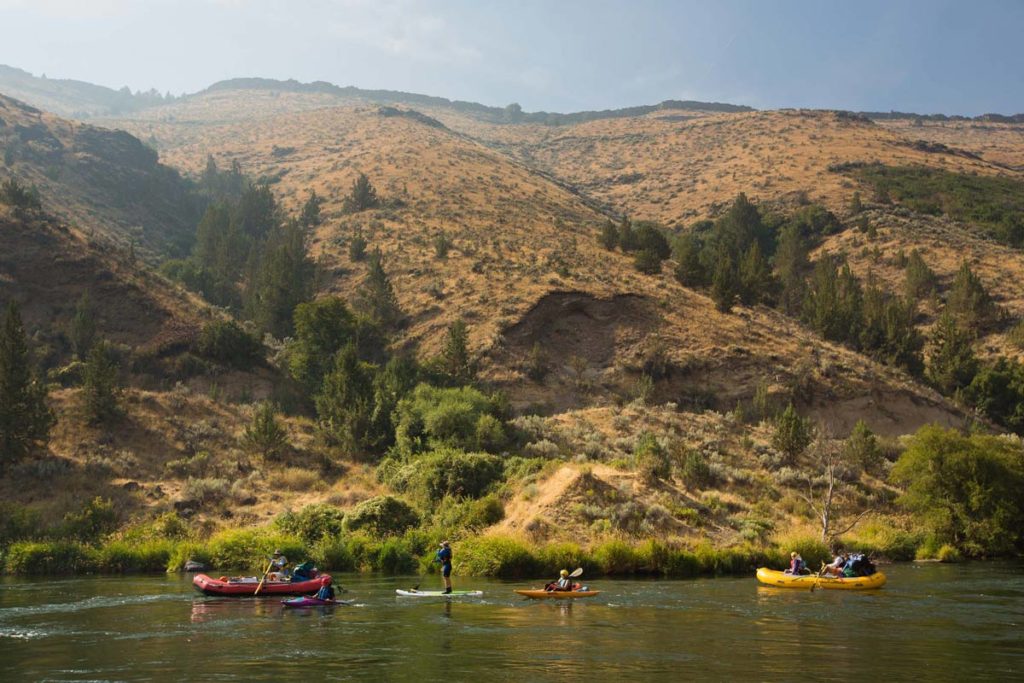
People floating down the river. One of my fears was that a flotilla would come by on the day of the eclipse and ruin my shot.

Another view from the campsite I was staying at. I considered this scene, but was afraid there were going to be too many people. There was also no spot really to position myself.
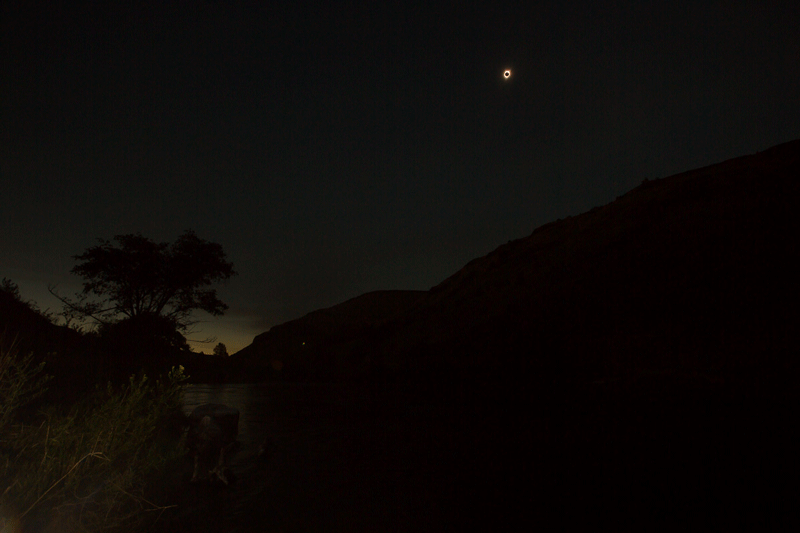
How dark did it get? There are only a few seconds between these shots. You can see the difference between a full eclipse and 99% eclipse.
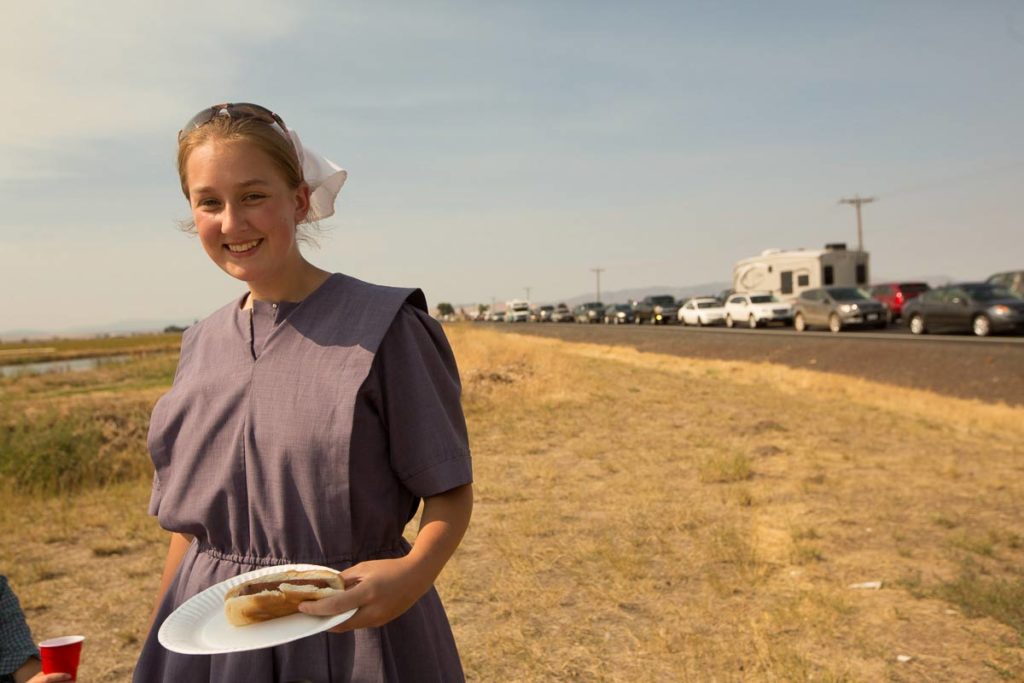
Sweet and very industrious locals setup a hot dog and cookie stand. After 3 days of eating canned food a simple hot dog never tasted that good.
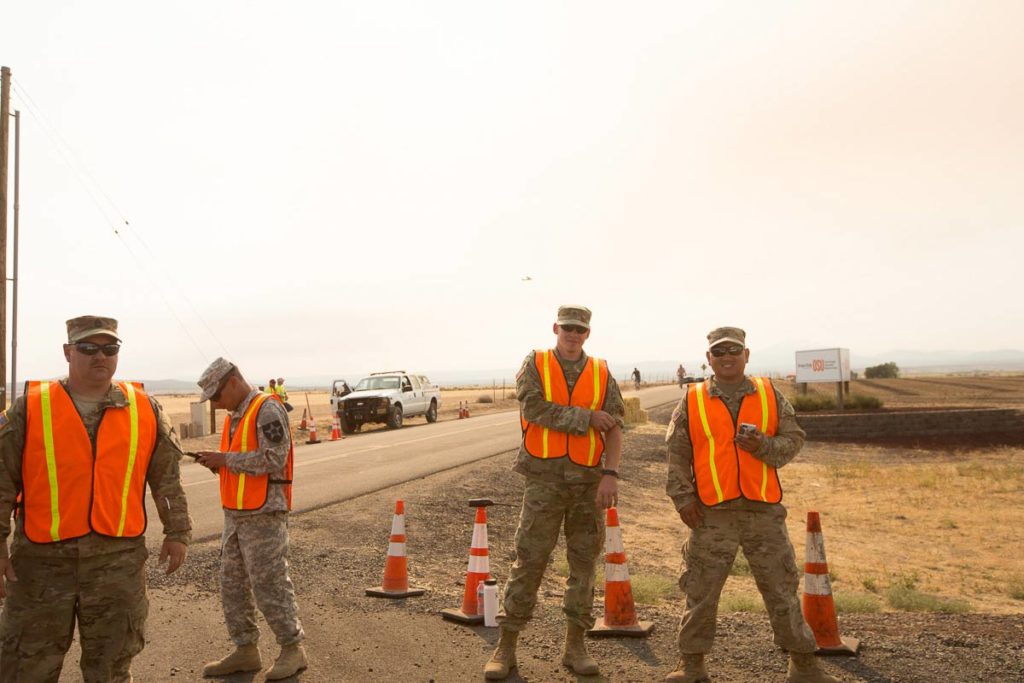
Taking this picture of these national guard troops saved me at least one hour. I stopped and took some pictures of these guys and figured that the road they were blocking was actually a way around the traffic jam. Nobody stopped me, sometimes it’s good to have a big camera.

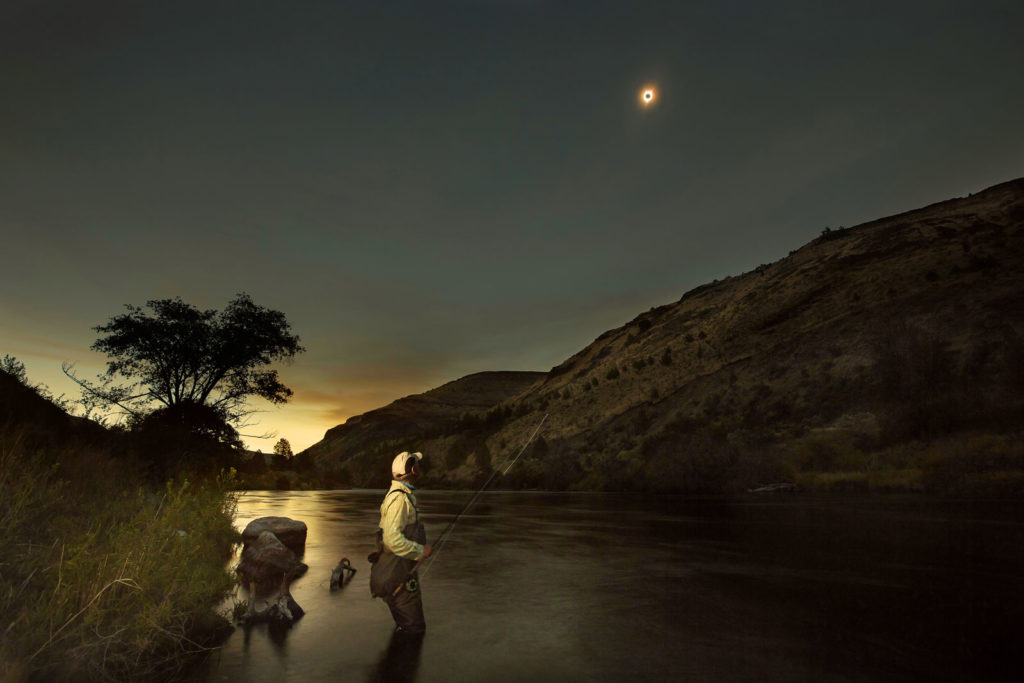

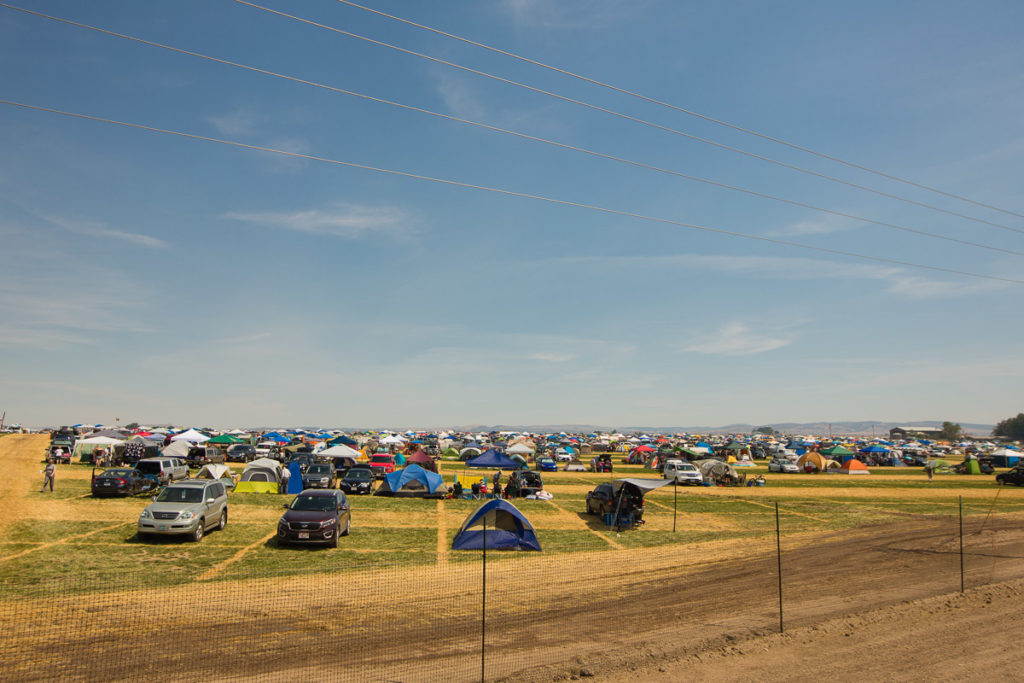



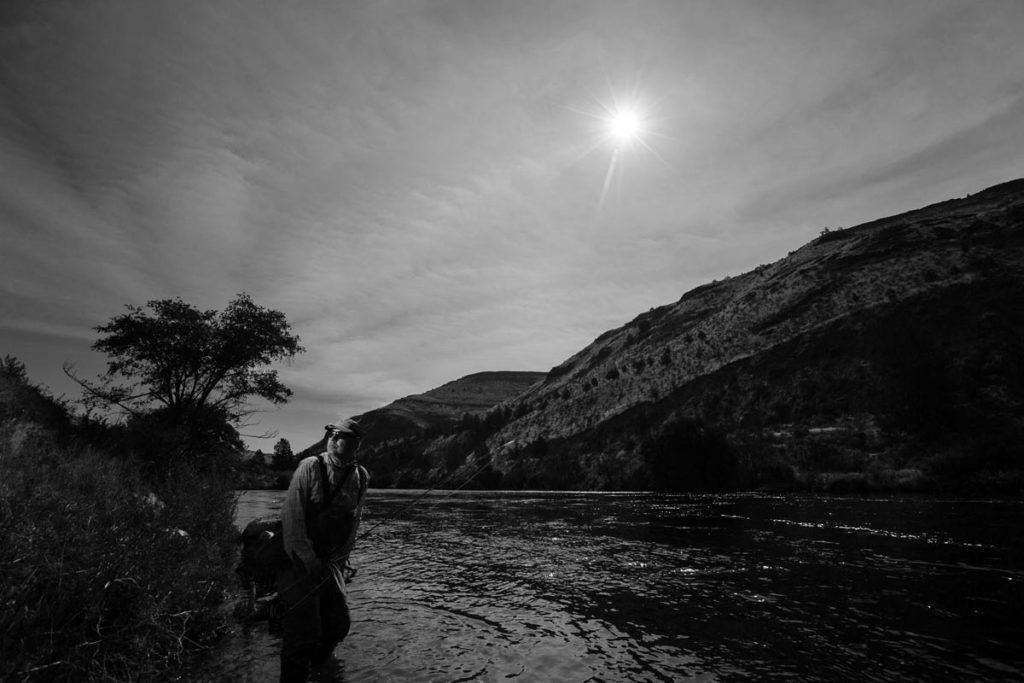
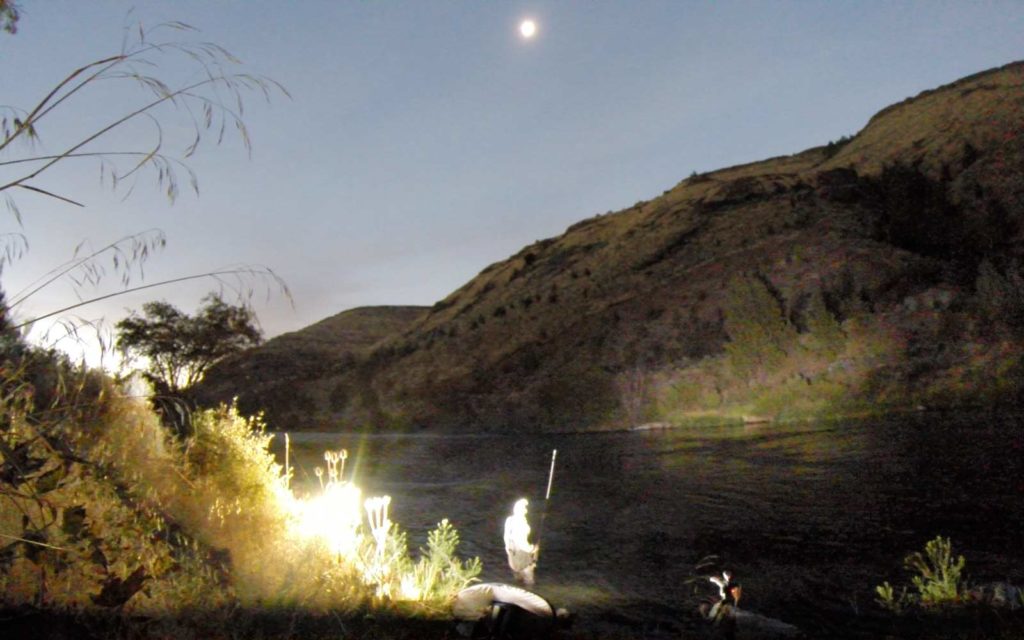
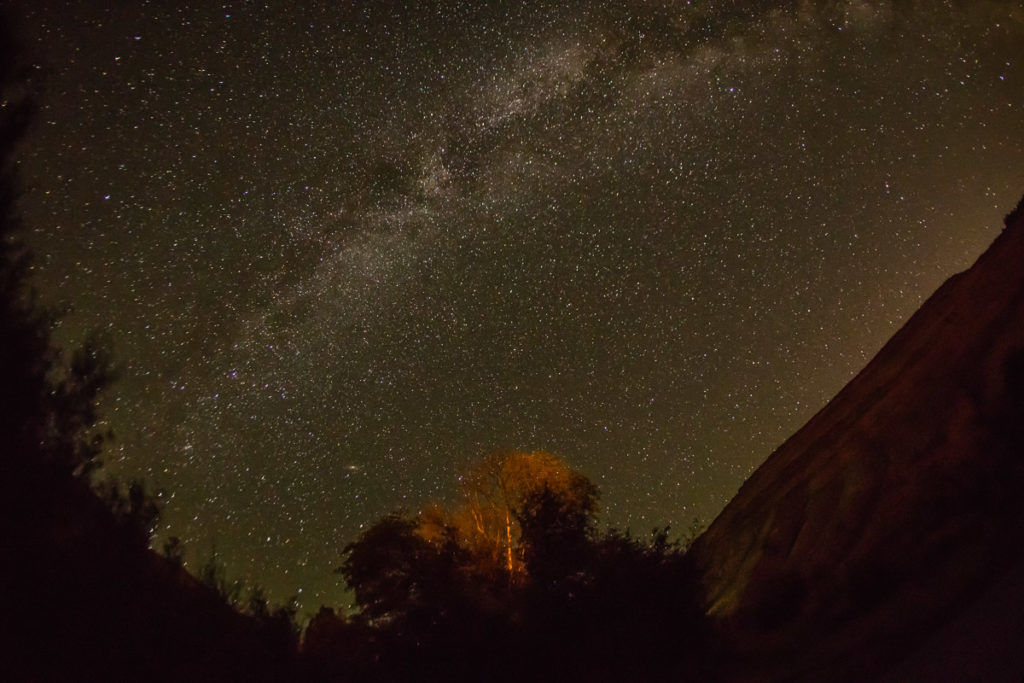
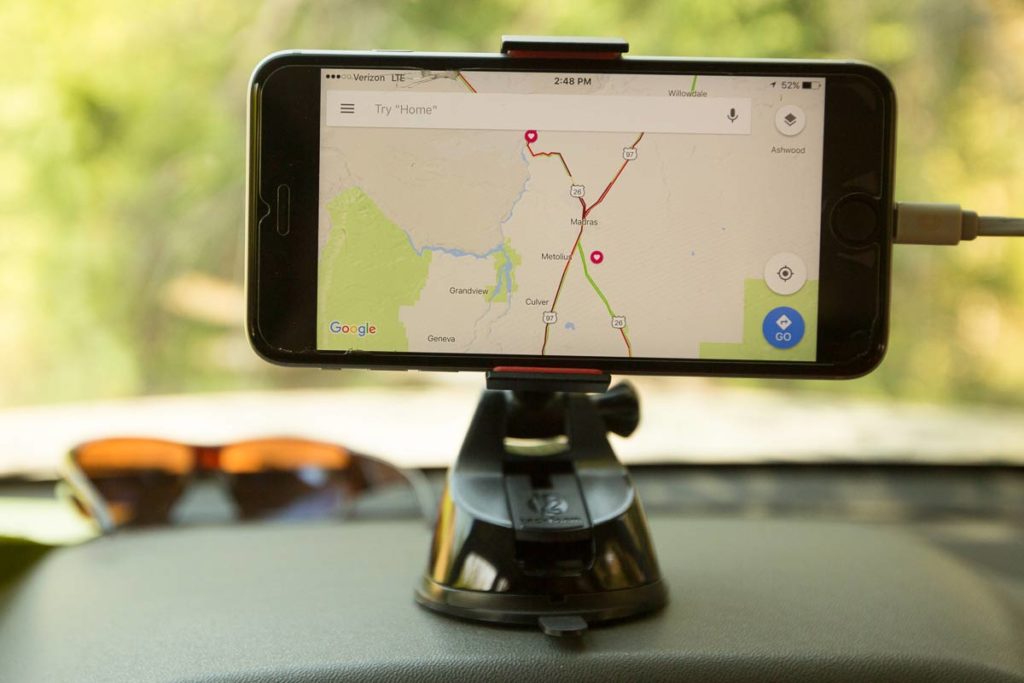
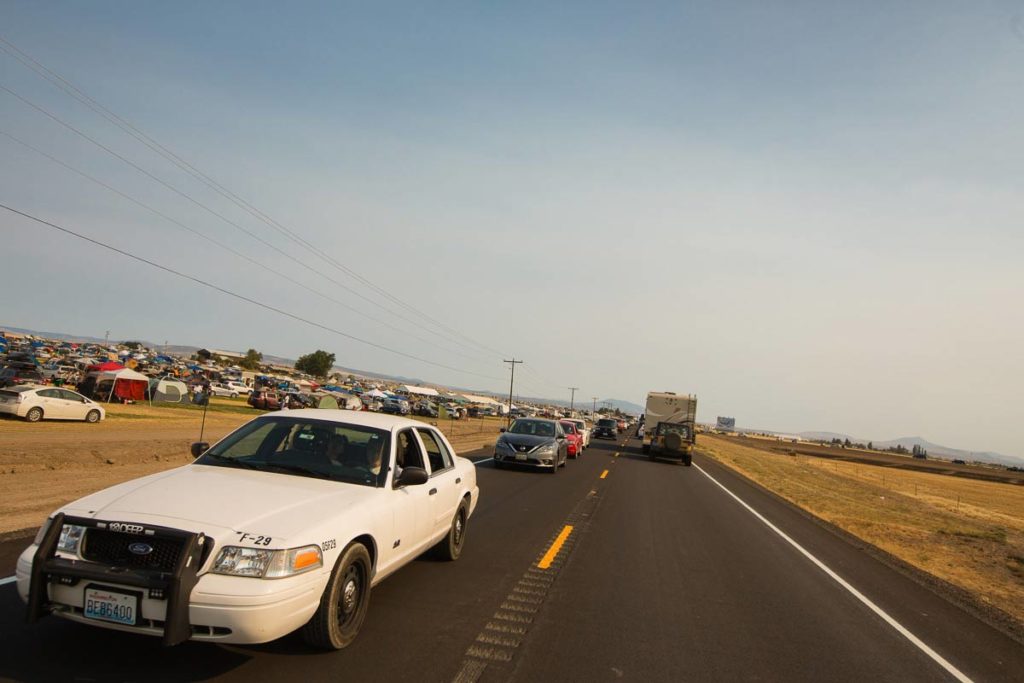

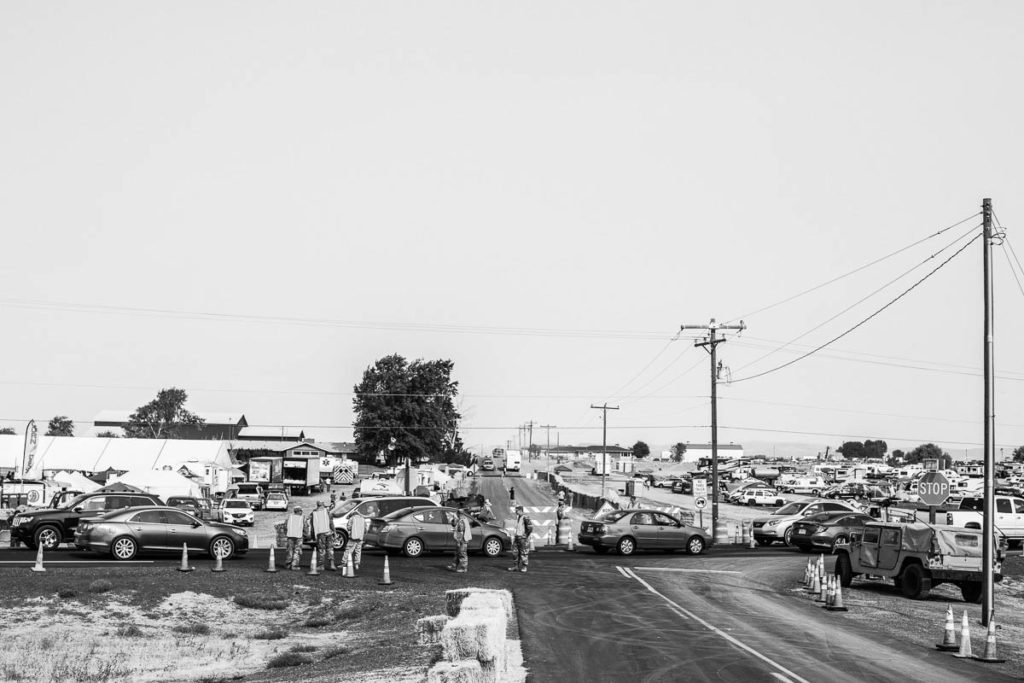

Leave a reply